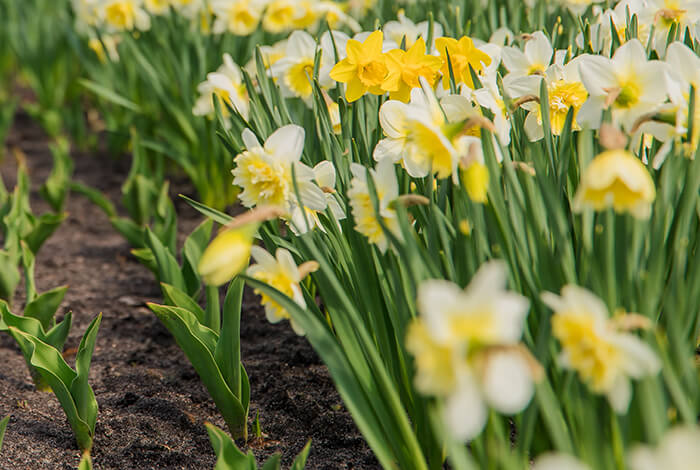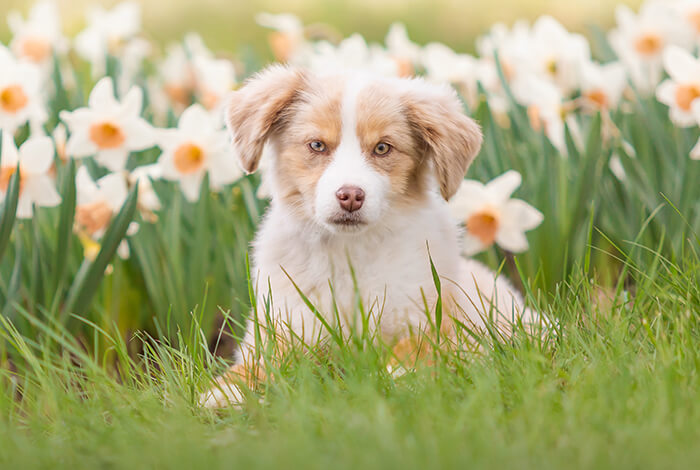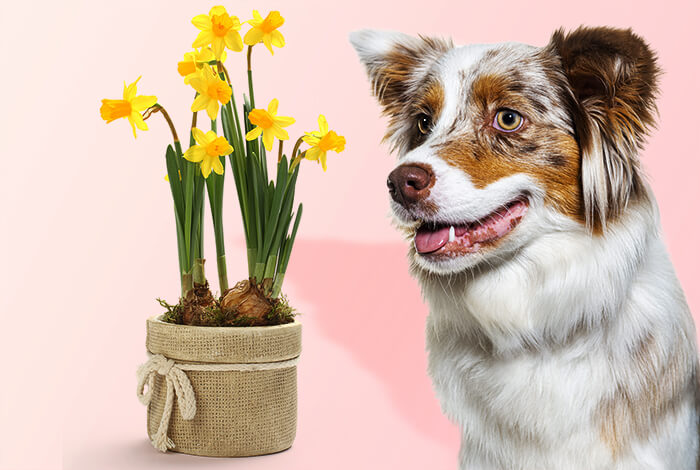![]() Reviewed By Joana Garrido DVM
Reviewed By Joana Garrido DVM
Are daffodils toxic to dogs? Daffodils are toxic to dogs as they possess a handful of poisonous compounds. Consuming these plants can host a variety of problems, from gastrointestinal issues to contact dermatitis.
Why Are Daffodils Toxic to Dogs?

Daffodils have a scientific name of Narcissus spp. They are also known as Narcissus but go by other monikers like:
- Jonquil
- Paper White
- Tazetta
These plants are garden favorites since they do not require extensive care compared to other plant species. Thus, pet owners with green thumbs might be enticed to grow them in their backyard.
Avoid making this mistake because daffodils contain at least 15 phenanthridine alkaloids, including lycorine, which causes their toxicity to canines. Ingestion of these chemicals often triggers stomach upset.
These toxic principles are also present in other poisonous plants, such as the amaryllis, snowdrops, and clivias.
Daffodils also possess microscopic yet sharp insoluble calcium oxalate crystals. Coming into contact with these raphides irritates the skin, resulting in dermatological problems.
How Toxic Are Daffodils to Dogs?

Daffodils are moderately poisonous plants to dogs. In most cases, the adverse effects of its toxins are mild and temporary.
However, consuming these plants in large amounts incites more severe ailments, such as abnormal cardiovascular and neurological function.
If pet owners fail to seek immediate medical assistance, these health problems can snowball into something life-threatening.
Read: 12 Poisonous Spring Plants for Dogs
What Parts of Daffodils Are Toxic to Dogs?

Not a single part of daffodils is safe for dogs, including the flowers, leaves, roots, and stems. All of them contain toxic phenanthridine alkaloids and skin-irritating insoluble calcium oxalate crystals.
However, these harmful compounds are highly concentrated in one part of the plant: its bulbs. For this reason, they are very poisonous, and even the dust on their surface is a potential health hazard. Inhaling it may damage the respiratory tract of your furry pal.
When daffodils are placed in a vase, their toxins may seep into the water. Thus, be extra careful where you dispose of the vase water to prevent your canine companion from lapping it up.
What Are the Symptoms of Daffodil Poisoning?

If a dog eats a daffodil, the first clinical signs that commonly appear are gastric issues like:
- Nausea
- Stomach cramp
- Vomiting
- Diarrhea
Ingesting excessive quantities of the daffodil plant will lead to the development of the following serious clinical signs:
- Convulsions
- Fast heart rate
- Heart arrhythmias
- Low blood pressure
- Tremors
- Seizures
Inhalation of the daffodil’s bulb dust may trigger these respiratory issues:
- Coughing
- Breathing difficulties
- Wheezing
Chewing on any part of the plant lodges its insoluble calcium oxalate crystals into the mouth’s skin tissues.
They cause contact dermatitis, which is dubbed “lily rash.” It takes the form of itchy rashes and painful blisters, which prompt dogs to constantly paw on the affected area.
Symptoms of daffodil poisoning in dogs typically take up to 2 hours to manifest. Thus, if you suspect that your furry friend has ingested the plant, monitor him closely within this time range.
What to Do If Your Dog Has Eaten a Daffodil?

Further ingestion of the plant is your priority, so make sure to restrict your pooch’s access to the plant. As mentioned above, munching on daffodils may result in oral irritation.
Washing your dog’s mouth with a gentle stream of water helps minimize the severity of this adverse reaction. Wiping his mouth with a damp towel produces the same effect as well.
Compiling vital information surrounding your dog’s ingestion of the daffodil is imperative. These include:
- What approximate time he consumed the plant
- Which parts of the daffodil have been eaten and the estimated amount consumed
- What clinical symptoms of daffodil poisoning are beginning to show
Share these details with a trusted veterinarian or an animal poison control helpline. They will provide advice on the next step you need to take.
Mild ailments caused by daffodil poisoning typically resolve by themselves within 1 to 2 days. Hence, affected canines are recommended for at-home treatment.
However, only make this decision once a medical professional instructs you to do so.
If the vet decides that diagnostic testing is necessary, don’t forget to take a sample of the plant with you to the animal clinic. It might be a useful clue in determining if your furry pal requires medical treatment.
How Is Daffodil Poisoning in Dogs Treated?
Early detection of daffodil ingestion in dogs allows the vet to induce vomiting. The process pushes affected pets to throw up undigested plant matter and minimize the absorption of toxins in their body.
If the situation calls for it, they will be given activated charcoal as well.
IV therapy will also be performed to filter out the poisonous compounds. Additionally, it aids in dehydration prevention by maintaining stable electrolytes and water levels.
Depending on the manifesting symptoms, the vet will prescribe medications to affected dogs. For example, those with oral irritation may need anti-inflammatory drugs, while pets suffering from vomiting require antiemetic.
FAQs About Are Daffodils Toxic to Dogs?
1. How Toxic Are Daffodils to Dogs?
Daffodils are relatively toxic to dogs. In small doses, they can cause gastric issues like nausea, vomiting, and diarrhea.
If pooches eat daffodils in copious quantities, more serious adverse effects may take place like heart problems and neurological disorders.
2. What Happens If My Dog Eats a Daffodil Bulb?
Severe toxicity may potentially occur if a dog eats a daffodil bulb. Keep in mind that this part of the plant contains the highest concentrations of toxins, making it extremely poisonous.
Ingestion could cause cardiovascular and neurological issues like increased heart rate and seizures. The dust on daffodil bulbs is also dangerous to pets as it can cause respiratory irritation when inhaled.
3. How Long Does Daffodil Poisoning Last in Dogs?
Unless daffodil poisoning in dogs is severe, this condition only lasts for a short period of time, usually around 1 to 2 days. Often, mild forms of toxicity do not require hospitalization.
However, even if you think that your dog is suitable for at-home treatment, we recommend checking with a vet first to ensure that you are making the right decision.
Conclusion
Are daffodils toxic to dogs? All parts of daffodils contain phenanthridine alkaloids and insoluble calcium oxalate crystals, making them toxic to dogs.
If ingested, a range of health issues may occur depending on how much of the plant was consumed.
In general, the daffodil can cause GI problems like vomiting and diarrhea when eaten in small amounts. On the other hand, excessive consumption may lead to cardiac and neurological issues like seizures and heart arrhythmia.
Moreover, direct contact with daffodils can potentially lead to skin irritation. This long list of dangers proves why you should avoid growing this plant if you own a dog.

